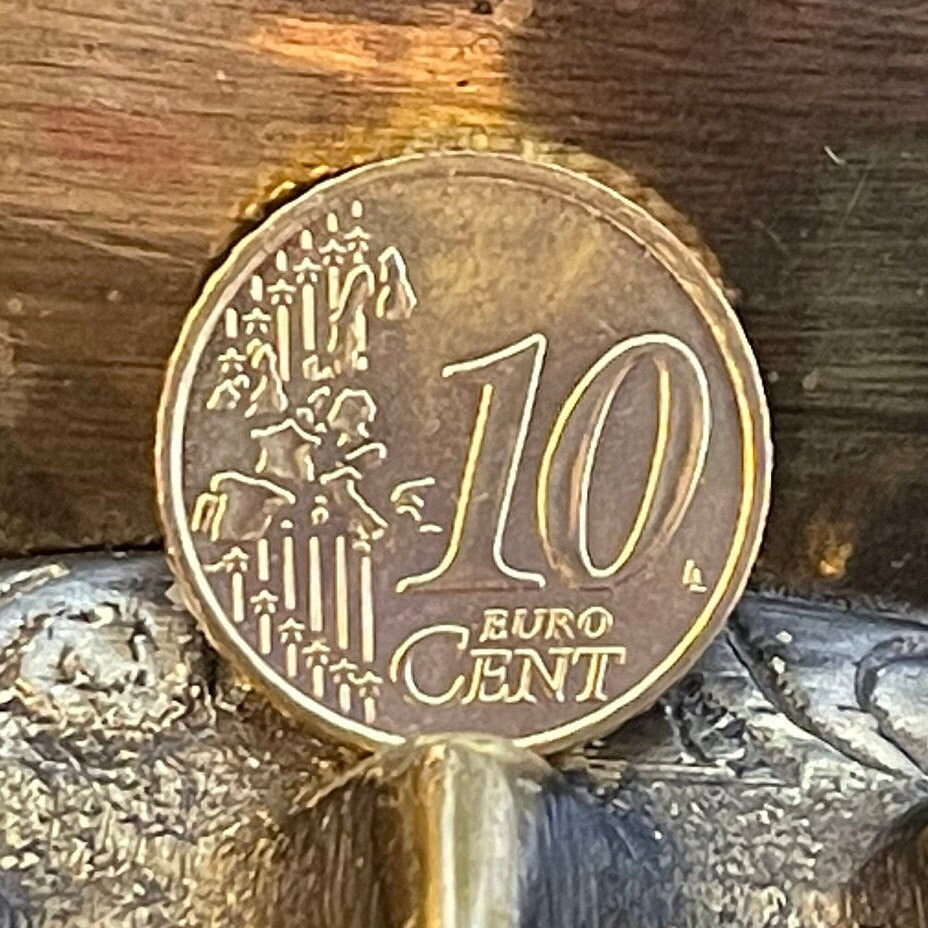elemintalshop
Revolutionary Poet Rigas Fereos 10 Euro Cents Greece Authentic Coin Money for Jewelry (Greek Enlightenment) (Greek Independence)
Revolutionary Poet Rigas Fereos 10 Euro Cents Greece Authentic Coin Money for Jewelry (Greek Enlightenment) (Greek Independence)
Couldn't load pickup availability
Rigas Fereos Revolutionary 10 Euro Cents Greece Authentic Coin Money for Jewelry and Craft Making (Greek Enlightenment) (Poet) (National Hero) (Martyr) (Greek Independence)
Obverse: A portrait of Rigas Fereos (1757-1798), a forerunner and leading figure of the Greek enlightenment and confederation, is accompanied with a legend indicating his name "Ρήγας Φεραίος" and the face value and is encircled by the twelve stars of Europe.
Lettering: 10 ΛΕΠΤΑ
ΡΗΓΑΣ ΦΕΡΑΙΟΣ
Translation: 10 CENTS
RIGAS FEREOS
Reverse: A map, next to the face value, symbolizes the gathering of the fifteen nations of the European Union.
Lettering: 10 LL
EURO CENT
Features
Issuer Greece
Period Third Hellenic Republic (1974-date)
Type Standard circulation coin
Years 2002-2006
Value 10 Euro Cent
0.1 EUR = USD 0.11
Currency Euro (2002-date)
Composition Nordic gold (89% Copper, 5% Aluminium, 5% Zinc, 1% Tin)
Weight 4.10 g
Diameter 19.75 mm
Thickness 1.93 mm
Shape Round
Technique Milled
Orientation Medal alignment ↑↑
Number N# 116
References KM# 184, Schön# 134
Wikipedia:
Rigas Feraios (Greek: Ρήγας Φεραίος pronounced [ˈriɣas fɛˈrɛɔs], sometimes Rhegas Pheraeos) or Velestinlis (Βελεστινλής pronounced [vɛlɛstinˈlis], also transliterated Velestinles); 1757 – 24 June 1798) was a Greek writer, political thinker and revolutionary, active in the Modern Greek Enlightenment. A victim of the Balkan uprising against the Ottoman Empire and a pioneer of the Greek War of Independence, Rigas Feraios is remembered as a Greek national hero.
Ideas and legacy
Rigas, using demotikì (Demotic Greek) rather than puristic (Katharevousa) Greek, aroused the patriotic fervor of his Greek contemporaries. His republicanism was given an aura of heroism by his martyrdom, and set liberation of Greece in a context of political reform. As social contradictions in Ottoman Empire grew sharper in the tumultuous Napoleonic era the most important theoretical monument of Greek republicanism, the anonymous Hellenic Nomarchy, was written, its author dedicating the work to Rigas Ferraios, who had been sacrificed for the salvation of Hellas.
His grievances against the Ottoman occupation of Greece regarded its cruelty, the drafting of children between the ages of five and fifteen into military service (Devshirmeh or Paedomazoma), the administrative chaos and systematic oppression (including prohibitions on teaching Greek history or language, or even riding on horseback), the confiscation of churches and their conversion to mosques.
Rigas wrote enthusiastic poems and books about Greek history and many became popular. One of the most famous (which he often sang in public) was the Thourios or battle-hymn (1797), in which he wrote, "It's finer to live one hour as a free man than forty years as a slave and prisoner" («Ως πότε παλικάρια να ζούμε στα στενά…. Καλύτερα μίας ώρας ελεύθερη ζωή παρά σαράντα χρόνια σκλαβιά και φυλακή»).
In "Thourios" he urged the Greeks (Romioi) and other Orthodox Christian peoples living at the time in the area of Greece (Arvanites, Bulgarians, etc.) and generally in the Balkans, to leave the Ottoman-occupied towns for the mountains, where they could find freedom, organize and fight against the Ottoman tyranny. His call included also the Muslims of the empire, who disagreed and reacted against the Sultan's governance.
It is noteworthy that the word "Greek" or "Hellene" is not mentioned in "Thourios"; instead, Greek-speaking populations in the area of Greece are still referred to as "Romioi" (i.e. Romans, citizens of the Christian or Eastern Roman Empire), which is the name that they proudly used for themselves at that time.
Statues of Rigas Feraios stand at the entrance to the University of Athens and in Belgrade at the beginning of the street that bears his name (Ulica Rige od Fere). The street named after Rigas Feraios in Belgrade was the only street in Belgrade named after a non-Serb until World War I.
Rigas Feraios was also the name taken by the youth wing of the Communist Party of Greece (Interior), and a branch of this youth wing was Rigas Feraios - Second Panhellenic.
His political vision was influenced by the French Constitution (i.e. democratic liberalism)
Feraios' portrait was printed on the obverse of the Greek 200-drachmas banknote of 1996-2001. A 50-drachmas commemorative coin was issued in 1998 for the 200th anniversary of his death. His image is stamped on the 0.10 Euro Greek coin.
Share



















